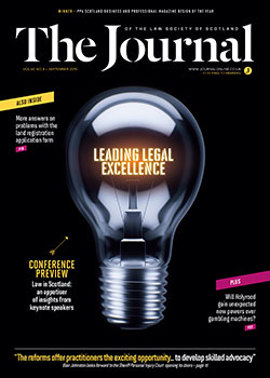The company one keeps

Corporate
A preliminary issue in a recent employment case, Garry Abrams Ltd v EAD Solicitors LLP (ET 2402068/2014 and 2402069/2014), has drawn the corporate community’s attention, as an employment tribunal has ruled it has jurisdiction to consider a claim of age discrimination brought by a limited company.
Expulsion v Retirement
Practitioners may recall the long-running case of Seldon v Clarkson Wright & Jakes [2012] UKSC 16; further procedure discussed at Journal, June 2013, 22, which held that a law firm partner’s mandatory retirement at 65 was objectively justified (though in that case Mr Seldon was an individual member of an unincorporated English partnership). It is worth noting here that no majority of the members of an LLP can expel another member unless a power to do so has been conferred by express agreement between the members (and so it is usual to include this in the LLP agreement: see Eaton v Caulfield [2011] EWHC 173 (Ch)).
In the Abrams case, EAD operated as a limited liability partnership and Mr Abrams was a member. A term of the LLP agreement stated that a member would retire on reaching 62. After receiving financial planning advice Mr Abrams decided to incorporate a limited liability company (“GAL”), and that GAL would become a member of the firm in his place, all with the agreement of EAD.
In keeping with Mr Abrams’ financial advice, it was ensured that no further contractual documentation was entered into between him and EAD, the only form of documentation being the deed of accession by which GAL became a member of EAD (together with Mr Abrams’ deed of retirement). The documents made it clear that whilst GAL remained a member of the firm of EAD, only a suitably qualified and appropriate solicitor was contracted to provide services to EAD – there was no obligation for Mr Abrams’ personal services to be provided.
GAL proceeded to receive a profit share from EAD (the fees Mr Abrams would have received as an individual member had he remained as such). A short time later, EAD made it known it expected Mr Abrams to cease working at the end of the financial year in which he turned 62 (in 2014), on the basis of the agreed retirement age in the LLP deed. When Mr Abrams did reach 62, the LLP stopped paying fees to GAL. Mr Abrams subsequently raised proceedings for associative age discrimination; after all, GAL was only a few years old at the time.
A corporate tribunal claim?
Claims for discrimination are usually brought by individual employees or workers against their employers using the Equality Act 2010. Section 13 of the Act defines direct discrimination, and s 45 requires that LLPs must not discriminate against their members. However, these sections do not require that the person bringing the claim is an individual.
In this case, arguments were advanced in relation to the meaning of “person”, the intention behind the 2010 Act and the Interpretation Act 1978. Section 120 of the 2010 Act details that the employment tribunal alone has jurisdiction to determine a complaint relating to contraventions of ss 39-83 (s 45(2) in relation to LLPs being the focus of this case). Accordingly the judge allowed the argument in relation to jurisdiction and, following a strict and literal interpretation of the Act, was persuaded that there was potential for GAL to advance a case of associative discrimination.
What next?
It was held that (on the facts peculiar to this case) a limited company could pursue a claim for discrimination where the reason behind the conduct toward the company was claimed to be an associated individual’s (i.e. Mr Abrams’) or group’s protected characteristic (in this case, age).
The consequences from the decision in Abrams could mean that incorporated entities, as well as individuals, could issue claims for discrimination. There could be an even greater ripple effect from the case if discrimination claims are able to be made by incorporated entities in relation to the provision of goods or services. Time will tell if the nine protected characteristics under the 2010 Act (which include age; disability; gender reassignment; marriage and civil partnership; pregnancy and maternity; race; religion or belief; sex; and sexual orientation) lead to an increase in discrimination claims from less traditional avenues.
In this issue
- Good health – fair question?
- Time to raise the age of criminal responsibility
- Adoption of foreign children – a clash of cultures?
- Presumed liability: the case for action
- Le Bief Bovet: 700 years of litigation
- Reading for pleasure
- Opinion: James O'Reilly (fuller version)
- Opinion: James O'Reilly
- Book reviews
- Profile
- President's column
- Land Register completion update
- People on the move
- Conference calls
- A new court rises
- Questions of form
- Charities - why reserves matter
- Place your bets
- Pensions: a formula unravelled
- Whereabouts unknown?
- Lego Man keeps his mark
- The company one keeps
- Scottish Solicitors Discipline Tribunal
- Land, leases and LBTT
- Big budget brief
- Support sought as Napier joins the law clinics
- Public Guardian's fees to increase
- Law reform roundup
- TCPD: the Update way
- How are we doing?
- Thanks, but no thanks
- Ask Ash






